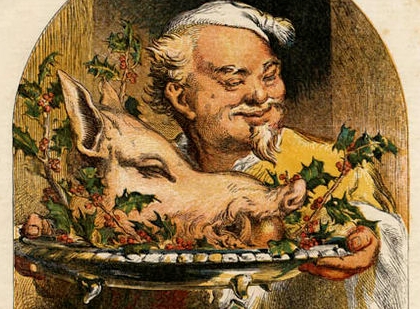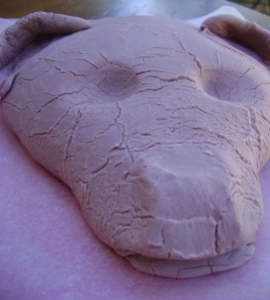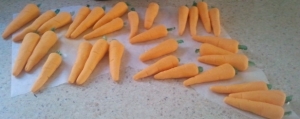Having made my marchpane as the basis for my subtletie (you can read about the process here) the next step was to turn it into an elaborate confection representing my medieval re-enactment group The College of St Ursula. Our official symbol is a bear but we also have a strong connection with carrots, so I wanted to incorporate those two elements into my subtletie. A popular type of subtletie involved making an animal look like it was still alive, so as a twist on the iconic subtletie of a boar’s head eating an apple I decided to make a bear’s head with a carrot in its mouth.

The tradition of processing a boar’s head at Yuletide goes back centuries, and the classic image forms the basis of my subtletie. By St. J. Gilbert, Christmas Supplement to the Illustrated London News, 1855. [Public domain], via Wikimedia Commons
First I had to make the sugar-paste, so I turned to this redaction of a sugar-paste recipe based on Thomas Dawson’s Good Hus-wiues Iewell. I used this recipe partially because it avoided the use of raw egg-white which makes a lot of people nervous, and since I didn’t know who would be eating it I thought it would be safer to just not use it. I also had a limited supply of gum tragacanth (known in period as gum dragon) which is what gives the icing its strength and, without time to order more if it went wrong, it seemed safest to start with a well-tested recipe. Unfortunately, disaster ensued. As I have since learned, the protein of the egg-whites is actually extremely important for strength, and without them the sugar-paste could not hold its shape. By morning the head had spread sideways, lost its shape and the surface had cracked. It was back to the drawing-board.

The first attempt at sugar-paste. The icing wasn’t strong enough to hold it’s shape and cracked horribly.
This time I found an article by Lady Deirdre O’Bardon[1] that referred to Barbara Wheaton’s redaction of a recipe by Alexis of Piedmont [2]. Wheaton’s redaction contained egg-whites and called for the mixture to be rested at several points which tallied with what I had read about improving the strength of the paste. I mixed it all together, using the rest of my gum tragacanth and, although it felt much softer than modern fondant, the combination of pre-soaking the gum and then resting overnight produced an excellent, malleable paste. The only thing that I was unhappy with were the lumps of gum which didn’t dissolve properly. This could probably have been avoided by whisking the liquids in more slowly or possibly even sieving the lumps out before adding the sugar.

The basic shape formed (I removed those eyes and did the texturing with sugar before adding them back again).
The next morning I coloured about 2/3 of the paste brown, leaving the rest aside for the carrots and detailing. Forming a smooth ball of sugar-paste I rolled one end into a flattish cone to form the nose and indented the eye sockets with my thumbs. I then cut open the mouth and placed a pencil into his mouth to keep it open while it dried and pinched some of the extra icing to form the ears before leaving the bear to dry for 24 hrs.
Once the bear was dry to the touch I added some of the extra white sugar-paste to the backs of the bear’s ears, building it up until I found the shape and thickness which I wanted. To make the bear more realistic I slathered him all over (except for the eyes and the front of the ears) in a simple icing mix of icing sugar, water and brown food colouring before sprinkling with dyed sugar (place raw sugar in a zip-lock back with food colouring and shake until evenly coloured). After the icing had dried I added more white sugar paste to the inside of the ears and rolled balls of icing to make the eyes. With the remaining sugar paste coloured orange I formed little carrots, rolling small balls into cones and gently impressing the sides with a sharp knife. I then used a skewer to make a small hole in the top and inserted small strips of green glacé cherries as stalks. These were left to dry for several hours.
To put it all together, I used a little more simple icing mix to stick the bear head to the marchpane. I surrounded it with sprigs of rosemary and arranged the small carrots on top, placing one into his mouth too of course.
The Recipe
Alexis of Piemont’s 1595 recipe To make a paiste of Suger, whereof a manne maie make all maner of fruites, and other fine thinges with their forme, as Platters, Dishes, Glasses, Cupps, and such like thinges, wherewith you maie furnishe a table: and when you have doen, eate them up. A pleasant thing for them that sitte at the table.
“Take gumme Dragant as much as you will, and seepe it in rose water, untill it bee mollified. And for fouwer ounces of suger take of it the bigness of a beane, the iuice of Limons a Walnut shell full, and a little of the white of anne egge; but you must first take the gum, and beate it to much with a pestell, in a morter of white marble, or of brasse, untill it become like water, then putte to it the iuice, with the white of the Egge incorporated well together. This doen take fower unces of fine white suger well beaten to powder, and cast into the morter by little and little, untill all be tourned into the forme of past. Then take it out of the saied morter, and braie it upon the powder of Suger, as it were meale or flwre, untill all bee soft paiste, to the ende you maie torne it and fashion it, which way you wil. When you have brought your paiste to this forme, spreade it abroade with sinamon upon greate or small leaves, as you shall think it good, and so shall you forme, and make what things you will, as is aforesaid: with such fine knackes as maie serve a table, taking heede that there stande no hot thing nigh unto it. At the end of the banket, they maie eate all & breake the platters, dishes, cuppes, and all thinges: For this paiste is verie delicate and savourous. If you will make a thing of more finesse than this, make a tarte of Almndes, stamped with suger and rose water, of like sorte that Marchpaines, bee made of. This shale you laie betweene twoo pastes of such vesselles, or fruites or some other thing as you thinke good.”[3]
Although I primarily used recipe from Alexis of Piedmont, I noticed that in Hugh Platt’s recipe to make sugar-paste he encourages the addition of starch to the powdered sugar which helps it to pass through the sieve. This is essentially the same as modern icing sugar mixture, and means that the sieving becomes almost unnecessary.
My Redaction
Elizabethan Sugar-paste
Adapted from Savouring the Past by Barbara Ketcham Wheaton
2 tsp powdered gum tragacanth
2 tsp rosewater
2 tbsp lemon juice
2 egg whites
4 cups of sifted icing sugar mixture (contains cornstarch as an anti-caking agent)
Gel food colouring as desired
1. Mix the gum tragacanth with the rosewater to form a gum. Leave for at least two hours.
2. Slowly whisk the lemon juice and egg white into the gum, trying to make it as smooth as possible.
3. Mix in the sugar gradually until it forms a dough, kneading the sugar in once the dough becomes too stiff to stir. Knead until all the sugar is incorporated and it is no longer sticky, adding extra sugar if necessary. Wrap in plastic wrap and leave at room temperature overnight.
4. Knead the food colouring into the paste, a few drops as a time. Shape into fruit, animals, plates etc as desired. For instructions on forming the bear, see above.
[1] Lady Deirdre O’Bardon, “Fun W Sugar Art,” Stefan’s Florilegium, February 15, 2011, http://www.florilegium.org/?http%3A//www.florilegium.org/files/FOOD-SWEETS/Fun-w-Sugar-art.html.
[2] Barbara Ketcham Wheaton, Savoring the Past: The French Kitchen and Table from 1300 to 1789 (Simon and Schuster, 2011), 246–247.
[3] Girolamo Ruscelli, The Secrets of the Reverent Maister Alexis of Piemont: Containing Excellent Remedies against Diverse Diseases, Wounds, and Other Accidents, with the Maner to Make Distillations, Parfumes, Confitures, Dying, Colours, Fusions, and Meltings … (London: P. Short for T. Wight, 1595), 61–62.



